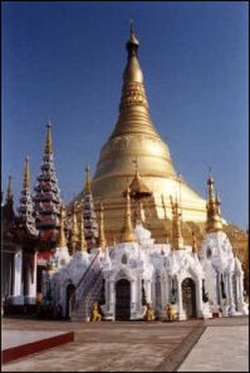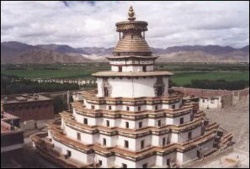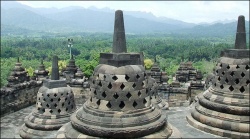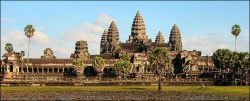Buddhist Temples and stupas
by Jeffrey Hays
There are essentially three kinds of Buddhist structures:
1) stupas, bell-shaped structures that contain a holy relic or scripture;
2) temples, place of worship somewhat similar to a church; and
3)monasteries, which contain living quarters and meditation cells for monks.
Local temples are essentially self sufficient and rely on their own lands and support from the local lay community to keep going. Property belongs to the community. There is not a hierarchy of priest, bishops and archbishops like there is Christianity.
The word pagoda is sometimes used to collectively describe stupas and temples but generally refers to Japanese- and Chinese style towers inspired by South Asian stupa. The word pagoda is derived from dagada , the word used for relic chamber in Sri Lanka. Classic Japanese- and Chinese-style pagodas usually have multiple stories, each with a graceful, tiled Chinese-style roof, and a top roof capped by a spire. The base represents the earth, the spire symbolizes heaven, and the connecting piece symbolizing the cosmic axis, to the Way.
History of Buddhist Temples
The word for temple in many languages is the same as cave. Many early Buddhist temples were "artificial caves" that attempted to recreate the atmosphere of Buddhist caves in northern India. Describing what they were probably like, the historian Paul Strachen wrote: In his book Pagan: Art and Architecture of Old Burma , "the now spartan brick gu [[[temple]])" was "cluttered with regal objects and requisites, a clamor of activity as food offerings were shuttled from the kitchens down passageways crowded with chanting devotees, brightly colored wall paintings, gilded furnishings and flapping banners and hangings...the usual plain, seated Buddha image, found in the deserted temples of Pagan today, would have been bathed, perfumed and dresses with the finest and most costly garments."
The architecture of Buddhist temples is influenced by the architecture of country in which they are found and various traditions of Buddhist architecture. Japanese pagodas, for example, have unique Japanese features that are modeled after Chinese-style pagodas, which in turn were modeled after Indian stupas.
After Buddha’s death his relics were divided and a number of stupas were built to house them. Although no ancient stupas remain the relics they housed are believed to have been saved and placed in other stupas. Many of the oldest stupas date back to the period of Buddhist expansions during the rule of King Ashoka (268-239 B.C.)
The objects inside stupas are often unknown. A gold reliquary excavated from a 2nd century B.C. stupa in Bimaran Afghanistan was decorated with images of Buddha and Hindu gods. The reliquary is believed to have contained the ashes of a revered saint or some object he touched.
Over the centuries many old stupas became pilgrimage sites. Famous ones became the center of complex ceremonial areas. They were often surrounded by a railing with gateways, through which pilgrims entered the ceremonial ground. Stone lions guarded the entrances. Outside vendors sold food and offerings to pilgrims.
Buddhist Temples
A temple is a place of worship as opposed to a shrine, which is a sacred place for praying. It generally contains an image of Buddha and has a place where Buddhists practice devotional activities. Temples attract large crowds during festivals or if they are famous but otherwise a fairly quiet. They are often sought as places for quiet meditation, with most acts of worship and devotion being done in front of an altar at home.
Buddhist temples are generally a cluster of buildings—whose number and size depends on the size of the temple—situated in an enclosed area. Large temples have several halls, where people can pray, and living quarters for monks. Smaller ones have a single hall, a house fore a resident monk and a bell. Some have cemeteries.
Temples can be several stories high and often have steeply sloped roofs are often supported by elaborately-decorated and colorfully-painted eaves and brackets. The main shrines often contain a Buddha statue, boxes of sacred scriptures, alters with lit candles, burning incense and other offerings as well as images of Buddhas, Bodhisattvas and devas. The central images depends on the sect.
Many temples are tourist attractions and outing destinations for local people. Souvenir amulets and other offerings are sold in little shops or booths; the names of large contributors are placed in special boxes; and priests are available to perform special rites.
The main hall is usually found at the center of the temple grounds. Inside are images of the Buddha, other Buddhist images, altars and space for monks and worshipers. The main hall is sometimes connected to a lecture hall, where monks gather to study and chant sutras.. Other buildings include a the sutra depositor, a library or place where Buddhist scripture are kept; living, sleeping, and eating areas for monks, and offices. Large temples often have special halls, where treasures are kept and displayed.
Features of Buddhist Temples
Buddhist temples usually contain numerous Buddha statues. The central Buddha images are often surrounded by burning incense sticks and offerings of fruit and flowers. Some contain the ashes or bone reliquaries of popular holy man. Many Buddhist temples face south and sometimes to the east, but never to the north and west which are regarded as unlucky directions according to Chinese feng shui. Many temples are entered through the left door and exited through the right.
Some temples have shrines for making prayers to the dead filled with funerary plaques with photographs of dead relatives. The photographs are often of deceased people whose funeral ceremony was performed at the temple. Some temple feature sets of wooden plaques with the names of large contributors and other sets with afterlife names of deceased people. In the old days the afterlife names were only given only to Buddhist priests but now they are given to lay people who paid the right price and now in some places have become a kind of ranking system in the after life based in how much one has contributed..
Many Buddhist temples contain large bells, which are rung during the New Year and to mark other occasions, and cemeteries. The pathway to the temples is often lined with stone or paper lanterns donated by worshipers, or strung with prayer flags. Many temples are filled with small shops selling religious items.
Buddhist Temple Gates
Buddhist temples usually have outer gates and inner gates protected by statues or paintings of beasts, fierce gods, or warriors that ward off evil spirits. The gateways are composed of wood, stone, bronze or even concrete. The beasts include Chinese lions and Korean dogs. Fierce guardian gods and warriors on the outer gate sometime have lighting bolts coming out of their nostrils and a serrated swords in their hands. Their duty is to keep demons and evil spirits out of the temple area.
The inner gate at the antechamber to the temple complex is often guarded by four guardian kings, representing the four cardinal directions. The king in the north holds a pagoda representing earth, heaven and cosmic axis. The king in the east holds a sword with the power to evoke a black wind that produces tens of thousands of spears and golden serpents. The king in the west possesses lute. And the king in the south holds a dragon and a wish-fulfilling jewel.
Some demon statues are covered with spitballs from worshipers who wrote prayers or petitions on pieces of paper, chewed them, and threw them on the demon statues in hope that the prayers would be answered. Usually they are fold paper.



